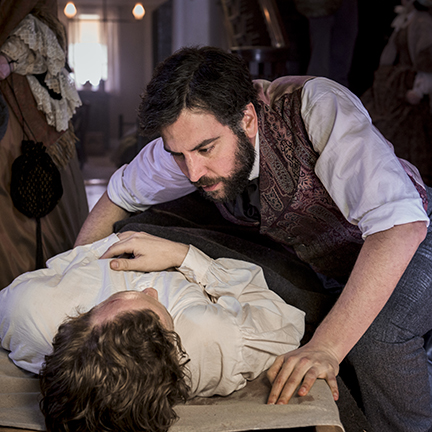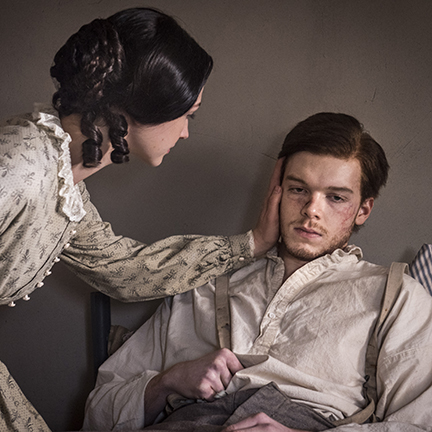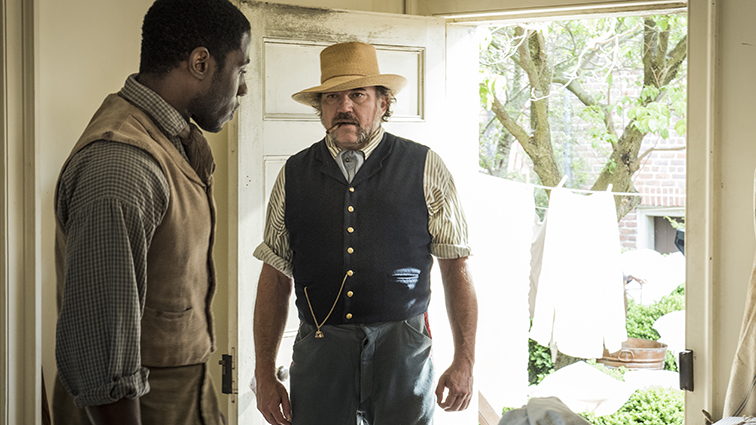Exploring Mercy Street: The Haversack
January 30, 2016 Leave a Comment
PBS has high hopes for Mercy Street. It’s the first original drama created by the network in over a decade and arrives in a media environment flush with ambitious television. The show is weighted with heavy expectations, its release timed to coincide with the final season of Downton Abbey. The apparent goal: A hit to succeed the British import and perhaps lead to more homegrown productions.
Mercy Street has received a promotional push commensurate to the investment PBS made in developing it, and it’s regularly compared to Downton, despite its creators’ insistence the two merely share their dramatic bent.
There are similarities between Mercy Street and Downton Abbey, though, beyond that they’re both prestige dramas. For starters, they are both simultaneously family and workplace dramas. Downton‘s Upstairs, Downstairs-inspired chronicle of the Crawley family and their manor full of servants inspires a tangled web of relationships. Mercy Street also combines family and work, but leads with its wartime hospital centerpiece and mostly Union Army staff. The family element is woven in through the Greens, a Confederate-sympathizing aristocratic clan that owned Mansion House, originally a luxury hotel, before the war.
Mercy Street and Downton Abbey are both period pieces, though set a half-century apart. The Civil War is the singular historical fulcrum of Mercy Street, and the show’s timeline is fairly tight. On the other hand, Downton spans decades, exploring the transformation of Edwardian England by World War I, the dissipation of heredity-based peerage, and the slow decline of the British Empire. Despite their differences, both eras are considered transformative for the politics and social structure of the U.S. and U.K.
Both programs are also contemporary in their storytelling emphasis. While their casts are large with multiple intersecting storylines, women are the primary characters in each show. In the case of Downton, it’s the three Crawley daughters. For Mercy Street, the broader story flows around a pair of nurses: Mary Phinney (Mary Elizabeth Winstead) and Emma Green (Hannah James). Unlike so many other high-profile prestige series over the last decade that centered on male anti-heroes, this focus on women sets Downton apart and may do the same for Mercy Street.
 Where the shows differ is genre. While it is a period piece about work and family, Mercy Street is also very noticeably a medical drama. So far, the show conforms quite closely to the dictates of hospital-bound TV. There are physicians, nurses and other staffers who work together, clash over their differences, and mingle the professional with personal. There is an element of horror, whether it’s gore and viscera or the looming recognition of death, and each episode offers new medical challenges, tackled with determination and innovation.
Where the shows differ is genre. While it is a period piece about work and family, Mercy Street is also very noticeably a medical drama. So far, the show conforms quite closely to the dictates of hospital-bound TV. There are physicians, nurses and other staffers who work together, clash over their differences, and mingle the professional with personal. There is an element of horror, whether it’s gore and viscera or the looming recognition of death, and each episode offers new medical challenges, tackled with determination and innovation.
The series premiere, “The New Nurse,” largely deals with introducing the characters and setting. This opener is direct about its medical drama identity, highlighting the moans of patients in pain, the telltale rot of gangrene, the spectacle of stacked post-amputation limbs, and other mainstays of a Civil War-era hospital. Of particular focus is a Confederate patient named Tom Fairfax (Cameron Monaghan). Anxious and distressed, he is diagnosed by Dr. Jed Foster (Josh Radnor) with “soldier’s heart,” an early recognition of post-traumatic stress disorder, which was subsequently known as shell shock (World War I) and combat fatigue (World War II) before acquiring its current name.
 The rhythms of hospital life define the second episode, “The Haversack.” Symmetrical in structure, it is presented as a day in the life of Mansion House as experienced by Mary Phinney. It begins with her early morning awakening, filled with the ringing of nails being pounded into casket lids, and closes to the late-night sounds of the same butcher’s bill.
The rhythms of hospital life define the second episode, “The Haversack.” Symmetrical in structure, it is presented as a day in the life of Mansion House as experienced by Mary Phinney. It begins with her early morning awakening, filled with the ringing of nails being pounded into casket lids, and closes to the late-night sounds of the same butcher’s bill.
Phinney makes the rounds of Mansion House, settling into her role as head nurse and seeking to bring order to the hospital’s chaos. This brings her into confrontation with Emma Green, who insists on providing succor to Confederate patients, and with Anne Hastings (Tara Summers), an experienced English nurse who resents Phinney’s authority. While trying to feed hungry patients, Phinney also clashes more dangerously with Silas Bullen (Wade Williams), the corrupt hospital steward whose mind is on taking advantage of the war’s chaos.
The centerpiece of the episode is when Dr. Foster conducts a trephination on a patient he diagnoses with a condition now known as expressive aphasia. Since this operation involves drilling a hole in the skull, it was considered fairly controversial at the time, and elicits opposition, both from Hastings and Dr. Byron Hale (Norbert Leo Butz), as well as curious acceptance from the hospital’s head physician, Dr. Alfred Summers (Peter Gerety).
Setting up the season for more drama, Hastings and Hale begin and end the episode in bed with each other, complaining about their colleagues and plotting. Foster considers extending his term at the hospital, which would likely mean an estrangement from his wife. Bullen escalates his abuses, hoarding food and raping an escaped slave, Aurelia Johnson (Shalita Grant), who works as a hospital laundress. Finally, the Green family deals with the Union occupation of Alexandria, but that begs another discussion for another day.
The medical side of Mercy Street is at the heart of the genre-blending series, which was originally conceived as a M*A*S*H*-like field hospital story. These elements will likely continue, given their importance in the show’s approach to period authenticity. These details are already garnering positive reviews, and are highlighted through the history-oriented Mercy Street Revealed blog published by PBS. The pairing of medical drama with period piece is actually pretty rare when it comes to TV, and it’s through this approach that Mercy Street might stand apart from Downton Abbey and other shows.
 Passport
Passport







0 thoughts on “Exploring Mercy Street: The Haversack”